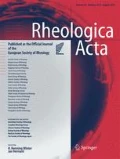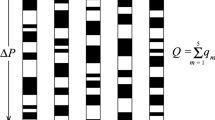Summary
A relative viscosity — volume concentration relationship,η r =η r (φ) deduced from an energy principle, which operates in newtonian range, is phenomenologically extended to the description of non-newtonian behaviour. Such an extension is performed, using a structural intrinsic viscosity\(\tilde k\), which depends on volume concentrationφ and shear rate\(\dot \gamma \). At constant\(\dot \gamma \), some new results concerningk(φ) are given, leading to determination of the thickness of a surfactant layer onto particle surface, and allowing good agreement to the semi-empirical viscosity relation given byThomas. At constantφ, a rate equation governs the evolution of\(\tilde k\) as a structural parameter. In steady conditions (\(\dot \gamma \) = const.), an equilibrium value\(\tilde k(\dot \gamma _r )\) is reached,\(\dot \gamma _r \) being a relative shear rate, depending on the overall time relaxation of the structure. A non-newtonian shear viscosity for steady flows is then obtained, depending on\((\dot \gamma _r )^p \). For systems of non-spherical particles, an empirical determination ofp givesp ≈ 0.5.
Zusammenfassung
Eine Beziehung zwischen relativer Viskosität und Volumenkonzentrationη r =η r (φ), die für den newtonschen Bereich aus einem Energieprinzip abgeleitet worden war, wird in phänomenologischer Weise zur Beschreibung des nicht-newtonschen Verhaltens verallgemeinert. Diese Verallgemeinerung wird mittels einer strukturabhängigen Grenzviskositätszahl (structural intrinsic viscosity)\(\tilde k\) erreicht, die von der Volumenkonzentrationφ und der Schergeschwindigkeit\(\dot \gamma \) abhängt. Für konstantes\(\dot \gamma \) werden einige neue Ergebnisse betreffend\(\tilde k(\phi )\) mitgeteilt, die zur Bestimmung der Dicke von oberflächenaktiven Schichten auf den Teilchenoberflächen führen und eine gute Übereinstimmung mit der halbempirischen Viskositätsgleichung vonThomas aufweisen. Für konstantesφ wird die Änderung von\(\tilde k\) durch eine Differentialgleichung beschrieben. Unter stationären Bedingungen (\(\dot \gamma \) = const) wird ein Gleichgewichtswert\(\tilde k(\dot \gamma _r )\) erreicht, wobei\(\dot \gamma _r \) eine relative Schergeschwindigkeit bedeutet, die vom Relaxationsverhalten der Struktur abhängt. Schließlich wird für stationäres Fließen eine nichtnewtonsche Scherviskosität erhalten, die von\((\dot \gamma _r )^p \) abhängt. Für Systeme mit nicht-kugelförmigen Teilchen ergibt sich ein empirischer Wert vonp ≈ 0,5.
Similar content being viewed by others
References
Quemada, D., Rheol. Acta16, 82–94 (1977).
Goldsmith, H. L., S. G. Mason, in:F. R. Eirich (ed)., Rheology, Theory and Applications, Vol. 4, Acad. Press (New York and London 1967), pp. 85.
Huggins, M. L., J. Phys. Chem.64, 2716 (1942).
Eilers, H., Kolloid. Z.97, 313 (1941).
Vand, V., J. Phys. et Colloid Chem.52, 277, 300, 314 (1948).
Saunders, F. L., J. Colloid Sci.16, 13 (1961).
Thomas, D. G., J. Colloid. Sci.20, 267 (1965).
Kuhn, W., H. Kuhn, Helv. Chim. Acta28, 97 (1941).
Batchelor, G. K., J. T. Green, J. Fluid. Mech.56, 401 (1972).
Ostwald, Wo., R. Auerbach, Kolloid-Z.38, 261 to 280 (1926).
Taylor, G. I., Proc. Roy. Soc. (London)A 138, 51 (1932);A 146, 501 (1934).
Smoluchowski, M. von, Kolloid-Z.18, 190 (1916).
Brooks, D. E., G. V. F. Seaman, in:H. H. Hartert, A. L. Copley (eds.), Theor. and Clinical Hemorheol. Springer-Verlag (Berlin 1971), pp. 127.
Papir, Y. S., I. M. Krieger, J. Colloid Interface Sci.34, 126 (1970).
Cheng, D. C. H., F. Evans, Brit. J. Appl. Phys.16, 1599 (1965).
Smoluchowski, M. von., Z. Phys. Chem.92, 129 (1917).
Batchelor, G. K., in:W. T. Koites (ed.), Theor. Appl. Mech., North Holland Pub. (1976), pp. 33.
Wolff, C., J. Chimie Phys.65, 1569–1579 (1968).
Krieger, I. M., Trans. Soc. Rheol.7, 101 (1963).
Hinch, E. J., L. G. Leal, J. Fluid Mech.52, 683 (1972).
Skalak, R., in:Grayson andZingg (eds.), Microcirculation I, Plenum Press (New York 1976), pp. 53–70.
Kirkwood, J. G., J. Riseman, J. Chem. Phys.16, 565 (1948);17, 442 (1949).
Williamson, R. V., Ind. Eng. Chem.21, 1108 (1929).
Krieger, I. M., T. J. Dougherty, Trans. Soc. Rheol.3, 137 (1959).
Cross, M. M., J. Colloid Sci.20, 417 (1965).
Casson, N., in:C. C. Mill (ed.), Rheology of Disperse Systems, Pergamon Press (London 1959), p. 84.
Gillespie, T., J. Coll. Sci.15, 219 (1960); J. Coll. Interf. Sci.22, 554;22, 563 (1966).
Author information
Authors and Affiliations
Additional information
With 2 figures and 5 tables
Rights and permissions
About this article
Cite this article
Quemada, D. Rheology of concentrated disperse systems II. A model for non-newtonian shear viscosity in steady flows. Rheol Acta 17, 632–642 (1978). https://doi.org/10.1007/BF01522036
Received:
Issue Date:
DOI: https://doi.org/10.1007/BF01522036




